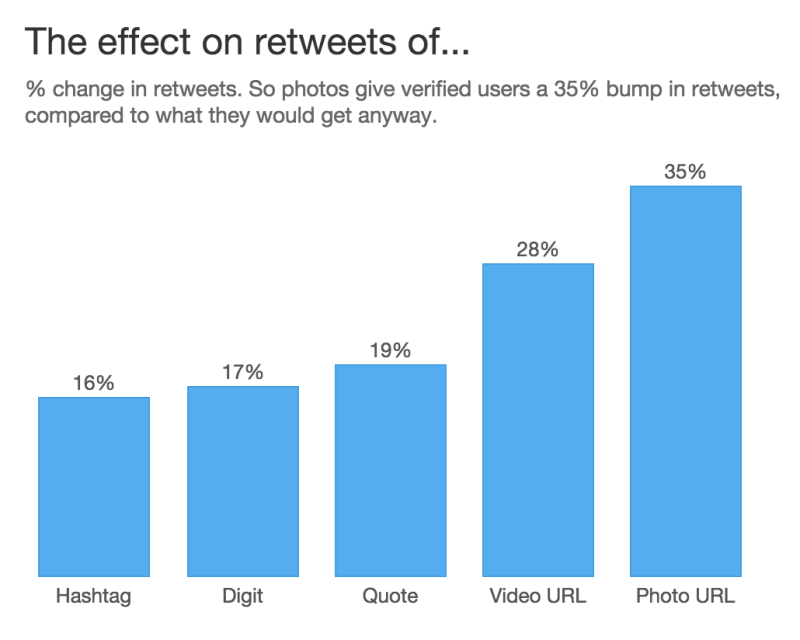More than two billion active social media accounts existed as of the first quarter of 2015, according to data compiled by We Are Social. The United States Department of Commerce reported that ecommerce generated more than $80 billion in sales in that same time.
Here are a few simple ways to leverage the billions of opportunities both of these channels represent for your ecommerce business.
Marry Your Product to Social Media Messages
Social media users love quotes. In fact, Buffer’s data reveals that tweets with quotes get retweeted almost 20 percent more often than original material.

Source: Buffer
Consider ways to integrate your digital products with quotes that help you leverage social media and your site simultaneously.
If your ecommerce site offers digital books, for example, free software like Recite allows you to copy and paste compelling quotes from books you sell. You can quickly transform these quotes into an aesthetically pleasing image that’s primed for sharing on social media. Major brands like Bloomberg have already integrated this approach into their posts on Twitter. The tweet below from Bloomberg uses a relevant quote and a GIF to entice followers to click through to their thought leadership content.
Hedge funds just nailed their short bets on U.S. stocks: http://t.co/2u3jp7LVaG pic.twitter.com/tmK0645HKA
— Bloomberg Terminal (@TheTerminal) August 25, 2015
Let the Customer Visualize the Experience
Images get noticed in today’s world of selfies and short attention spans. Aside from the fact that Buffer’s data reveals that tweets with photos get retweeted 35 percent more than those without, images allow you to build your brand on popular social media channels like Vine, Pinterest and Instagram, which use images as the primary means of engagement.
Ecommerce businesses used to be challenged with the hurdle of creating a visceral customer experience without the help of a tangible showroom. The popularity of video and images on social media now give customers a way to experience your ecommerce brand and its digital products — even though they’ll never physically touch, see or smell it.
As AdWeek recently reported, the music streaming service Spotify successfully used Twitter’s Periscope app to create a live streaming video of a performance of the popular Irish folk band, The Villagers. Because Spotify provides its users access to the artist’s music, the video indirectly promoted Spotify, and it gave the audience an idea of its brand and the type of listener it wants to attract.
Invite the Customer to Be Influential
Whether you post videos, text posts, images or quotes, invite your customers and prospects to be more than bystanders to your ecommerce business. If you’re launching a new digital product, for example, invite social media users to weigh in on the details. Ask them for suggestions about product names, or consider holding a naming contest that will encourage the social media audience to get involved in the voting process.
Companies like Intuit (which offers the cloud-based accounting software QuickBooks) have used social media to hold “Love a Local Business” contests that invite small business owners to apply for a monetary award that they’ll use to fuel their growth.
The applicants (who may or may not be QuickBooks customers) tell the story behind their business by completing an online application. Intuit then highlights various contestants on its social media channels — and encourages applicants to share news of the contest with their social networks, who can vote for them to improve their odds of winning. Like Spotify’s approach, the contest doesn’t overtly promote Intuit’s digital products — but it certainly builds awareness of them to audiences who may be a perfect fit for them.
Think Surround-Sound
How did Angry Birds — a $0.99 downloadable mobile game that was released to the public in 2009 — explode into a billion dollar franchise that now includes merchandise, video games and apparel? The founders of Rovio Entertainment made a commitment to have “an active and continuous relationship” with the customer, reports Wired UK. They created a video trailer on YouTube which has since generated more than 17 million hits; they committed to answering every customer interaction, including letters, and any and all social media engagement. Eventually, all that grass roots social media marketing led to an established digital brand.
Customer relationships are not simply about a one-time interaction, so use social media to keep communicating with them.
Keystone
Social media is a cost-efficient way to breathe life into your ecommerce business, and can help you reach new audiences on a shoestring budget. Experiment with the different social media channels and tactics to find the ideal fit for your audience —and watch the shares (and ecommerce sales) roll in.
Kristen Gramigna is Chief Marketing Officer for BluePay, a credit card processing firm. She has more than 20 years experience in the bankcard industry. Check out her previous post on cleverbridge, or follow her on Twitter at @BluePay_CMO.